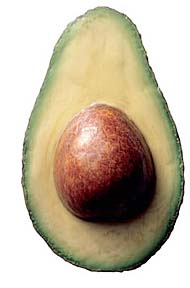

Key Ingredient

|
KEY INGREDIENT: AVOCADOS
Avocados have gotten a bad rap in recent years. Some see the buttery fruit as unhealthy because of its high fat content, but fail to realize that it contains the good monounsaturated fats that have been linked to reducing cholesterol. Avocados are also nutrient- and vitamin-rich and an excellent source of potassium.The basics: The avocado, also known as alligator pear or simply pear locally, is the fruit of an evergreen tree. It is native to Central America and Mexico, where it is a prized ingredient. Avocados came to Hawaii in the early 19th century as an experiment in new agricultural crops.
Today hundreds of varieties are grown throughout the world. The small, bumpy, dark-skinned Hass and the larger, smooth, green-skinned Fuerte are the most popular varieties grown in the United States.
Locally, the Sharwil, a thick-skinned, green variety from Australia is a popular commercial crop grown mainly in Kona. Other thin-skinned green varieties are readily found at farmers markets and in Chinatown.
All varieties of avocados have a yellowish green, creamy flesh that surrounds a large pit. They range in size from 3 ounces to 3 pounds and come in a variety of shapes, from round to pear. Taste and texture also vary within the different varieties.
Selecting: Avocados ripen after they are picked, so they are generally quite firm when they hit the markets. If you need to use an avocado immediately, look for fruit that yields to pressure. Otherwise, pick fruit that is unblemished, firm and heavy for its size. The skin of the Hass avocado will turn dark in color when ripe, while the green-skinned varieties will remain a glossy green.
Storing: To speed ripening, place avocados in a paper bag at room temperature. Ripe fruit may be stored in the refrigerator for a couple of days.
Use: Cut avocados lengthwise in half. Remove the pit by hitting it with a knife and giving it a twist. Either scoop out the flesh with a spoon or slice lengthwise or into cubes and peel off the skin. A bit of lime or lemon juice will help prevent discoloration of the exposed flesh.
Avocados should be consumed raw. The creamy flesh will turn bitter if cooked.
Although guacamole and California sushi rolls are obvious uses, try a cold avocado soup made with garlic, cream, lime juice and vegetable stock or add avocado to fruit salad. Avocado ice cream is also gaining in popularity.
Where to buy: Avocados can be found year-round with some varieties more prevalent in the fall. Hass avocados are generally available at $1.99 to $2.50 a pound. But seek out local varieties when possible at farmers markets or even on a neighborhood tree.
Food Stuffs: Morsels
Eleanor Nakama-Mitsunaga is
a free-lance food writer. Contact her
online through features@starbulletin.com